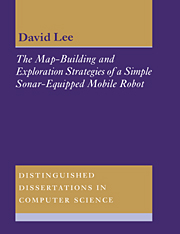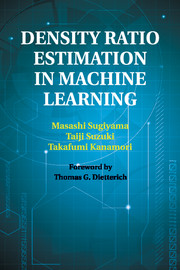Refine search
Actions for selected content:
48285 results in Computer Science
CHAPTER 9 - PRIME EXTENSIONS
-
- Book:
- A Course in Model Theory
- Published online:
- 05 June 2012
- Print publication:
- 08 March 2012, pp 157-164
-
- Chapter
- Export citation
CHAPTER 10 - THE FINE STRUCTURE OF ℵ1-CATEGORICAL THEORIES
-
- Book:
- A Course in Model Theory
- Published online:
- 05 June 2012
- Print publication:
- 08 March 2012, pp 165-184
-
- Chapter
- Export citation
APPENDIX A - SET THEORY
-
- Book:
- A Course in Model Theory
- Published online:
- 05 June 2012
- Print publication:
- 08 March 2012, pp 185-190
-
- Chapter
- Export citation
CHAPTER 5 - ℵ1-CATEGORICAL THEORIES
-
- Book:
- A Course in Model Theory
- Published online:
- 05 June 2012
- Print publication:
- 08 March 2012, pp 63-88
-
- Chapter
- Export citation
CHAPTER 3 - QUANTIFIER ELIMINATION
-
- Book:
- A Course in Model Theory
- Published online:
- 05 June 2012
- Print publication:
- 08 March 2012, pp 27-46
-
- Chapter
- Export citation
INDEX
-
- Book:
- A Course in Model Theory
- Published online:
- 05 June 2012
- Print publication:
- 08 March 2012, pp 239-248
-
- Chapter
- Export citation
PREFACE
-
- Book:
- A Course in Model Theory
- Published online:
- 05 June 2012
- Print publication:
- 08 March 2012, pp ix-x
-
- Chapter
- Export citation
CUFP 2011 Workshop Report
- Part of
-
- Journal:
- Journal of Functional Programming / Volume 22 / Issue 1 / January 2012
- Published online by Cambridge University Press:
- 06 March 2012, pp. 1-8
-
- Article
-
- You have access
- Export citation
Applying integer programming to AI planning
-
- Journal:
- The Knowledge Engineering Review / Volume 15 / Issue 1 / March 2000
- Published online by Cambridge University Press:
- 06 March 2012, pp. 85-100
-
- Article
- Export citation
The small-community phenomenon in networks†
-
- Journal:
- Mathematical Structures in Computer Science / Volume 22 / Issue 3 / June 2012
- Published online by Cambridge University Press:
- 06 March 2012, pp. 373-407
-
- Article
- Export citation
VALENTINI’S CUT-ELIMINATION FOR PROVABILITY LOGIC RESOLVED
-
- Journal:
- The Review of Symbolic Logic / Volume 5 / Issue 2 / June 2012
- Published online by Cambridge University Press:
- 06 March 2012, pp. 212-238
- Print publication:
- June 2012
-
- Article
- Export citation
Bridging the gap between planning and scheduling
-
- Journal:
- The Knowledge Engineering Review / Volume 15 / Issue 1 / March 2000
- Published online by Cambridge University Press:
- 06 March 2012, pp. 47-83
-
- Article
- Export citation
INDISPENSABILITY ARGUMENTS AND INSTRUMENTAL NOMINALISM
-
- Journal:
- The Review of Symbolic Logic / Volume 5 / Issue 4 / December 2012
- Published online by Cambridge University Press:
- 06 March 2012, pp. 687-709
- Print publication:
- December 2012
-
- Article
- Export citation
Combining satisfiability techniques from AI and OR
-
- Journal:
- The Knowledge Engineering Review / Volume 15 / Issue 1 / March 2000
- Published online by Cambridge University Press:
- 06 March 2012, pp. 31-45
-
- Article
- Export citation
Integer optimization models of AI planning problems
-
- Journal:
- The Knowledge Engineering Review / Volume 15 / Issue 1 / March 2000
- Published online by Cambridge University Press:
- 06 March 2012, pp. 101-117
-
- Article
- Export citation
Semantic subtyping with an SMT solver
- Part of
-
- Journal:
- Journal of Functional Programming / Volume 22 / Issue 1 / January 2012
- Published online by Cambridge University Press:
- 06 March 2012, pp. 31-105
-
- Article
-
- You have access
- Export citation
A scheme for unifying optimization and constraint satisfaction methods
-
- Journal:
- The Knowledge Engineering Review / Volume 15 / Issue 1 / March 2000
- Published online by Cambridge University Press:
- 06 March 2012, pp. 11-30
-
- Article
- Export citation
Artificial intelligence and operations research: challenges and opportunities in planning and scheduling
-
- Journal:
- The Knowledge Engineering Review / Volume 15 / Issue 1 / March 2000
- Published online by Cambridge University Press:
- 06 March 2012, pp. 1-10
-
- Article
- Export citation

The Map-Building and Exploration Strategies of a Simple Sonar-Equipped Mobile Robot
- An Experimental, Quantitative Evaluation
-
- Published online:
- 05 March 2012
- Print publication:
- 26 July 1996

Density Ratio Estimation in Machine Learning
-
- Published online:
- 05 March 2012
- Print publication:
- 20 February 2012
